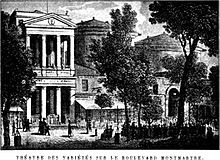Boulevard Montmartre
| Boulevard Montmartre | |
|---|---|
| location | |
| Arrondissement | 2. 9. |
| quarter | Vivienne Faubourg-Montmartre |
| Beginning | 1, Rue du Faubourg-Montmartre 169, Rue Montmartre |
| The End | 112, rue de Richelieu 2, rue Drouot |
| morphology | |
| length | 215 m |
| width | 35 m |
| history | |
| Decision making | Lettres patentes de juillet 1676 |
| designation | March 2, 1864 |
| Coding | |
| Paris | 6441 |
The Boulevard Montmartre ([ bulvaʁ mɔ̃.maʁtʁ ], German "Märtyrerhügel" ) is a 215 meter long boulevard in the 2nd and 9th arrondissement of Paris and is one of the four Grands Boulevards des Rive Droite .
location
The Boulevard Montmartre lies between the Boulevards Poissionière and Haussmann . It starts at rue Montmartre / rue du Faubourg Montmartre and ends at rue de Richelieu / rue Drouot. It is served by Métro Paris by Métroline 8 and 9 ( Richelieu - Drouot stop ).
Name origin
The boulevard derives its name from the nearby Porte Montmartre and not from Montmartre , as the name suggests, because it is not located on this hill.
history
The Boulevard Montmartre was created after the outdated fortress wall by Louis XIII was removed . in 1679, which had become superfluous, and whose old ramparts led through undeveloped farmland (swamp area). It was ordered by letters patent as part of the reorganization of the streets in Paris. Work began in July 1676 and ended in 1705.
The area between the boulevard and the old perimeter wall, which was located behind today's Rue Feydeau (formerly Rue des Fossés-Montmartre), was urbanized from the end of the 17th and beginning of the 18th century with the construction of private villas, the land in the north from the middle of the 18th century through the construction of the Augny mansion (today the town hall of the 9th arrondissement of Paris ).
The boulevards Saint-Denis , Saint-Martin , du Temple , de Filles du Calvaire and Beaumarchais were built in June 1670 . In July 1676 a patent approved its construction, which came to a preliminary end in 1705 and was finally completed in 1763. It got its name after the old city gate Porte Montmartre , which was demolished in 1633. During the French Revolution it was called boulevard Montmarat (another word for Montmartre) between 1793 and 1795 . On May 4, 1826, a royal decree fixed its width at 35 meters, and on March 2, 1864 it was given its current name.
building
At No. 1 was that of Louis XV. founded Café de la Porte Montmartre with international newspapers, which was named after the city gate located here. Its current address is 29 boulevard Poissonnière . The Théâtre des Variétés at no. 7 was opened on June 24, 1807 by Marguerite Brunet. From 1864, five world premieres of Jacques Offenbach's works took place here. The Passage Jouffroy in No. 10–12 was created in 1846 and is extended on the opposite side by the Passage des Panoramas (No. 11–13). Café Véron was built in No. 13 in 1818 , and Café Frascati, which was demolished in 1838, was built in No. 23 as early as 1789 . The famous wax museum Musée Grévin opened on June 5, 1882 in No. 10, the composer Gioachino Rossini lived between 1828 and 1832 in what is now the Hôtel Ronceray (No. 10-12), the Hard Rock Cafe (No. 14) began in September 1991 .
Others
Camille Pissarro created several versions of the painting under the title Boulevard Montmartre on a winter morning in 1897 .
Web links
Individual evidence
- ↑ Information on road construction in Paris can be found in fr: Réseau viaire de Paris
- ^ Paris guide: Les Principaux Écrivains et Artistes de la France - La vie. 1867, p. 1300.
- ^ Jetta S. Wolff: Historic Paris. 2014, no p.
Coordinates: 48 ° 52 ′ 18 ″ N , 2 ° 20 ′ 29 ″ E







